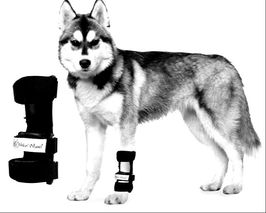
Tendonitis
A tendon is a strip of tissue that connects the muscle to the bone. "Tendonitis" happens when a tendon is inflamed, irritated, stretched, torn or ruptured. In dogs, the most common tendon injuries occur in the forepaws and shoulders, however tendonitis can happen in any tendon. Treatment of canine tendonitis varies depending on the severity of the injury.
Causes
Tendonitis can come about due to traumatic injury, overexertion or repetitive strains. Less active dogs that are maybe overweight, or in a poor physical condition can easily injure a tendon when participating in a new activity that requires more physical exertion than the dog is used to. A sudden unexpected rotation of the hock in the rear leg can lead to a rupture of the Achilles tendon for example. While tendonitis can occur in any dog breed, the sporting breeds and agility dogs are at a higher risk of this type of injury due to their increased physical activities. Injuries to the Achilles tendon are a regular occurrence in greyhounds. Agility dogs generally injure the tendons in the shoulders due to repetitive strains. Extreme obesity would therefore increase the risk of strain on the tendons.
Symptoms
The more severe symptoms will depend on the location and the degree of the injury to the tendon. Possibly you will notice your dog limping or adjusting its natural gait. They may visibly show pain when you touch or move the area. Other possible symptoms include a lack of energy or a desire to participate in favourite activity, the limb may well be visibly trembling.
Diagnosing Tendonitis
If you suspect your dog has tendonitis it is showing possible signs of it, a visit your veterinarian as soon as possible is advisable. The veterinarian may well want to rule out conditions such as possible broken bones or other injuries in the event of a traumatic event. The veterinarian will then perform X-rays, ultrasounds or an MRI to help make the tendonitis diagnosis.
Treatments
In a case of minor tendonitis, pain medications NSAIDS will help ease pain, while cryotherapy or icing helps reduce inflammation. A veterinarian may well recommend physical therapy, hydrotherapy, laser therapy or acupuncture to aid in healing. In some cases, your veterinarian can administer injections of hyaluronic acid or cortisone directly into the tendon; this can give almost immediate relief. In cases of chronic tendonitis or ruptured tendons, surgical intervention however may be necessary; this is then followed by rest and rehabilitation.
A tendon is a strip of tissue that connects the muscle to the bone. "Tendonitis" happens when a tendon is inflamed, irritated, stretched, torn or ruptured. In dogs, the most common tendon injuries occur in the forepaws and shoulders, however tendonitis can happen in any tendon. Treatment of canine tendonitis varies depending on the severity of the injury.
Causes
Tendonitis can come about due to traumatic injury, overexertion or repetitive strains. Less active dogs that are maybe overweight, or in a poor physical condition can easily injure a tendon when participating in a new activity that requires more physical exertion than the dog is used to. A sudden unexpected rotation of the hock in the rear leg can lead to a rupture of the Achilles tendon for example. While tendonitis can occur in any dog breed, the sporting breeds and agility dogs are at a higher risk of this type of injury due to their increased physical activities. Injuries to the Achilles tendon are a regular occurrence in greyhounds. Agility dogs generally injure the tendons in the shoulders due to repetitive strains. Extreme obesity would therefore increase the risk of strain on the tendons.
Symptoms
The more severe symptoms will depend on the location and the degree of the injury to the tendon. Possibly you will notice your dog limping or adjusting its natural gait. They may visibly show pain when you touch or move the area. Other possible symptoms include a lack of energy or a desire to participate in favourite activity, the limb may well be visibly trembling.
Diagnosing Tendonitis
If you suspect your dog has tendonitis it is showing possible signs of it, a visit your veterinarian as soon as possible is advisable. The veterinarian may well want to rule out conditions such as possible broken bones or other injuries in the event of a traumatic event. The veterinarian will then perform X-rays, ultrasounds or an MRI to help make the tendonitis diagnosis.
Treatments
In a case of minor tendonitis, pain medications NSAIDS will help ease pain, while cryotherapy or icing helps reduce inflammation. A veterinarian may well recommend physical therapy, hydrotherapy, laser therapy or acupuncture to aid in healing. In some cases, your veterinarian can administer injections of hyaluronic acid or cortisone directly into the tendon; this can give almost immediate relief. In cases of chronic tendonitis or ruptured tendons, surgical intervention however may be necessary; this is then followed by rest and rehabilitation.

